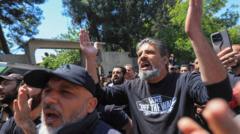In the quiet Damascus suburb of Ashrafiyat Sahnaya, the chaotic echoes of gunfire shattered the peace and instilled deep fear within Lama al-Hassanieh. On that harrowing day, she locked herself in her bathroom as armed men, some clad in military garb, roamed the streets, calling for violence against the Druze community. Labeled as hereditary enemies by Islamist factions, the Druze, adherents of a distinct faith with ties to Shia Islam, are grappling with an unprecedented sense of insecurity.
Historically, the Druze maintained a tenuous alignment with Bashar al-Assad, navigating their survival amidst Syria's tumultuous civil war by supporting a regime that projected itself as the protector of religious minorities. However, as Islamist militant groups gain dominance and threaten the safety of ‘heretical’ communities, many Druze fear being unmoored once again.
Recent events, including a fabricated audio recording, ignited violence directed at Druze neighborhoods, resulting in significant bloodshed. According to the Syrian Observatory for Human Rights, damaging clashes resulted in the deaths of over a hundred individuals, both combatants and civilians, within just a few days. The government’s portrayal of these incidents as necessary measures for security has exacerbated distrust among the Druze community.
Lama Zahereddine, a pharmacy student, recalls the harrowing sounds of mortars falling in her village and the desperate evacuation orchestrated by her uncle amidst the chaos. The violence found its way into universities as well, where students faced aggression based on their Druze identity, underscoring an alarming tide of sectarian hostility.
As inter-community violence appears to target the Druze, their calls for accountability and protection from the state have gone unanswered. With trust eroding, the lines of solidarity are blurred, leaving many community members questioning who understands their plight. "I don’t know who to trust anymore," Lama laments, reflecting the growing sentiment of disillusionment.
In light of this crisis, some Druze volunteers have rallied to protect their communities, facing aggressive retaliations from armed groups that remain indistinguishable from the interests ostensibly crafted by the government. Hadi Abou Hassoun, a volunteer who attempted to shield his neighborhood from attack, suffered severe injuries during an ambush, epitomizing the brutal reality Druze defenders confront.
Despite international attention, with Israel targeting areas it perceives as threatening to the Druze populace, local sentiments and experiences remain deeply rooted in mistrust. The pervasive question lingers: where is the Syrian state in ensuring the safety of its citizens?
In the calm that has followed the recent violence, a fragile peace has emerged - yet underlying tensions remain palpable. As fractured trust hangs in the balance, the Druze community's desire for equality and respect looms large. "We are Syrians, and we seek the same rights as everyone else," expresses Lama, a plea for recognition and accountability that reverberates through a community at a pivotal crossroad in Syria's ongoing turmoil.





















